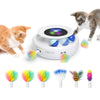Asthma in Cats🙀🐈🐈

An incident of feline asthma may initially be dismissed as simply another hairball or a little of food traveling down the "wrong pipe." Coughing on a regular basis, on the other hand, is likely to draw the notice of the owner. Asthma can cause a cat to cough and then appear normal, but it is a degenerative disorder that must be treated. A veterinarian should check a coughing cat to evaluate the problem and ensure that it is treated appropriately.
What Is Asthma?
Cat asthma is an allergen-driven respiratory disease that causes breathing difficulties, much like human asthma. When a cat inhales an allergen, their immune systems may overreact. The immune response that follows results in an overabundance of chemicals being produced in the blood, which leads to severe airway inflammation.
Symptoms of Asthma in Cats
Early asthma symptoms may be difficult to detect and severe attacks may be infrequent, making them easy to dismiss as hairballs. Over time, symptoms tend to become more prevalent and noticeable.
Symptoms
- Wheezing
- Tiring easily
- Coughing/choking sounds
- Gagging
One of the symptoms that distinguishes cat asthma from hairballs or other physical obstructions is a slight wheezing sound when the cat breathes, which may be more noticeable after vigorous play or running.
Swollen and inflamed airways secrete excess mucus, which narrows, making it difficult for the cat to breathe. The cat rapidly becomes fatigued due to reduced oxygen supply.
During a full-blown asthma attack, the cat curls up on the floor and stretches its neck and head to help clear mucus from the airways. The cat may swallow, sneeze, cough or even vomit. Cats may or may not expel frothy mucus.
Asthma attacks can be fatal, and your cat must be taken to the vet immediately. Even if your cat shows only one or two early symptoms, it should be examined. Once a diagnosis has been made, there are a number of steps you can take to help your cat.
Causes of Asthma
Many of the same allergens responsible for human asthma attacks can also trigger feline asthma attacks, including:
- Cigarette smoke
- Mildew or mold
- Household chemicals
- Dust
- Pollen
- Cat litter particulates
Stress can either cause or exacerbate a feline asthma attack. For that reason, you should always try to remain as calm as possible when your cat suffers an attack.
Diagnosing Asthma in Cats
Veterinarians use a variety of diagnostic tests to diagnose asthma in cats. The most common diagnostic tools include:
- Blood Tests: A series of blood tests can help your veterinarian assess your cat's overall health, rule out other diseases, and determine if inflammation is present in your cat's body.
- Chest X-ray: This diagnostic method, also known as a chest x-ray, helps your veterinarian look for abnormalities in the lungs, such as areas of chronic inflammation or abnormal fluid buildup. Sometimes cats with asthma will see a bright branching pattern on the x-ray. This indicates an accumulation of inflammatory cells in the airways.
- Bronchoalveolar lavage (BAL): Under general anesthesia, a tracheal tube is inserted into the cat's airway. This allows the veterinarian to take a sample of fluid directly from the cat's airways. In addition to asthma, BAL can be used to diagnose other diseases of the lungs.The disadvantage of BAL is that it requires general anesthesia and is therefore not recommended for cats with severe respiratory distress or disease.
Treatment
The basic and most common management strategies for feline asthma include a steroid to help reduce inflammation within the airways and a bronchodilator to keep the airways open so that the cat can more easily breathe.
Sometimes these medications are given orally, but another form of administration is with a metered-dose inhaler, such as Flovent, given through a special mask. The Aerokat Feline Aerosol Chamber was developed for this purpose. The advantage of aerosol steroid administration over pills and injections is that it goes directly into the lungs, rather than throughout the body, thus creating fewer side effects.
If your cat is having more severe attacks than you consider normal, visit your veterinarian for re-evaluation and possible adjustment of medications.
Prognosis for Cats With Asthma
Feline asthma is a chronic, progressive disease with no cure. Your veterinarian will work to develop an ongoing medication management plan to keep your cat as comfortable as possible for its lifetime.
Once your cat is diagnosed with feline asthma, you have several options for lifestyle changes that can help reduce recurring asthma attacks, depending on the severity of the case. The first and most obvious thing you'll need to do is to try to eliminate the environmental allergens that are causing respiratory distress in your cat.
As with most feline health issues, the key to successful management of feline asthma is to know your cat well, keep your eyes and ears open for changes in the breathing, give medications as prescribed, and get veterinary care when indicated, either routine checkups or emergency intervention.
How to Prevent Asthma
A cat can become asthmatic if it lives in an environment with allergens that trigger its immune system to overreact. To reduce the risk of your cat developing asthma, take these preventative measures:
- Reduce smoking: If you smoke, you'll need to do it outdoors in the future. Better yet, consider quitting, for your health and for all the creatures who share your home.
- Eliminate mold and mildew: Conduct a deep cleaning. Although it may sound contraindicated, a steam cleaner does a good job of cleaning mold and other allergens from solid surfaces such as tile floors, shower enclosures, and walls. Professional services are indicated for cleaning central air ducts.
- Curtail dust and dust mites: Frequent vacuuming can help reduce dust and mites. Although expensive, HEPA air purifiers are excellent for removing both dust mites and mold spores from the air. Consider a room purifier in the room your cat most frequently occupies. A HEPA purifier will also help during the pollen season.
- Edit household chemicals: Use environmentally friendly cleaning products for your cats' benefit, your health, and your home environment. Ideally, refrain from using air fresheners and potpourris, scented laundry detergents, and perfumes that can cause respiratory issues in sensitive cats.2
- Change cat litter: Because of the dust that rises from clay litters, most of them are not good for asthmatic cats. 3 Consider using wood or paper-based cat litter without added fragrance. Remember that cats are often fussy about litter changes, so introduce the new litter gradually.
- If you suspect your pet is sick, call your veterinarian immediately. Always consult with your veterinarian about health concerns, as they have examined your pet, know his or her health history, and can make the best recommendations for your pet.




